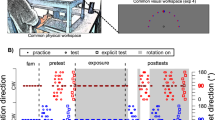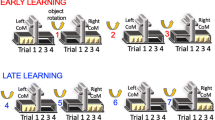Abstract
Studies have shown that humans cannot simultaneously learn opposing force fields or opposing visuomotor rotations, even when provided with arbitrary contextual information, probably because of interference in their working memory1,2,3,4,5,6. In contrast, we found that subjects can adapt to two opposing force fields when provided with contextual cues and can consolidate motor memories if random and frequent switching occurs. Because significant aftereffects were seen, this study suggests that multiple internal models can be acquired simultaneously during learning and predictively switched, depending only on contextual information.



Similar content being viewed by others
References
Gandolfo, F., Mussa-Ivaldi, F.A. & Bizzi, E. Proc. Natl. Acad. Sci. USA 93, 3843–3846 (1996).
Brashers-Krug, T., Shadmehr, R. & Bizzi, E. Nature 382, 252–255 (1996).
Krakauer, J.W., Ghilardi, M.F. & Ghez, C. Nat. Neurosci. 2, 1026–1031 (1999).
Wigmore, V., Tong, C. & Flanagan, J.R. J. Exp. Psychol. Hum. Percept. Perform. 28, 447–457 (2002).
Karniel, A. & Mussa-Ivaldi, A. Exp. Brain. Res. 143, 520–524 (2002).
Tong, C., Wolpert, D.M. & Flanagan, J.R. J. Neurosci. 22, 1108–1113 (2002).
Shadmehr, R., Donchin, O., Hwang, E.J., Hemminger, S.E. & Rao, A. Motor Cortex and Voluntary Movements (ed. Vaadia, E.) (CRC Press, Boca Raton, Florida, USA, in the press).
Bock, O., Schneider, S. & Bloomberg, J. Exp. Brain. Res. 138, 359–365 (2001).
Cunningham, H.A. & Welch, R.B. J. Exp. Psychol. Hum. Percept. Perform. 20, 987–999 (1994).
Welch, R.B., Bridgeman, B., Anand, S. & Browman, K.E. Percept. Psychophys. 54, 195–204 (1993).
Kravitz, J.H. & Yaffe, F.L. Percept. Psychophys. 12, 305–308 (1972).
Takahashi, C.D., Scheidt, R.A. & Reinkensmeyer, D.J. J. Neurophysiol. 86, 1047–1051 (2001).
Burdet, E., Osu, R., Franklin, D.W., Milner, T.E. & Kawato, M. Nature 414, 446–449 (2001).
Wolpert, D.M. & Kawato, M. Neural Netw. 11, 1317–1329 (1998).
Wada, Y. et al. Neurosci. Res. 46, 319–331 (2003).
Acknowledgements
This research was supported by the Telecommunications Advancement Organization of Japan and the Human Frontier Science Program. We thank T. Milner for improving the manuscript.
Author information
Authors and Affiliations
Corresponding author
Ethics declarations
Competing interests
The authors declare no competing financial interests.
Supplementary information
Rights and permissions
About this article
Cite this article
Osu, R., Hirai, S., Yoshioka, T. et al. Random presentation enables subjects to adapt to two opposing forces on the hand. Nat Neurosci 7, 111–112 (2004). https://doi.org/10.1038/nn1184
Received:
Accepted:
Published:
Issue Date:
DOI: https://doi.org/10.1038/nn1184
- Springer Nature America, Inc.
This article is cited by
-
The heavier the arm, the higher the action: the effects of forearm-weight changes on reach-to-grasp movements
Experimental Brain Research (2022)
-
The overlooked ubiquity of first-person experience in the cognitive sciences
Synthese (2021)
-
Bidirectional competitive interactions between motor memory and declarative memory during interleaved learning
Scientific Reports (2020)
-
How different effectors and action effects modulate the formation of separate motor memories
Scientific Reports (2019)
-
Adaptive changes in automatic motor responses based on acquired visuomotor correspondence
Experimental Brain Research (2019)





